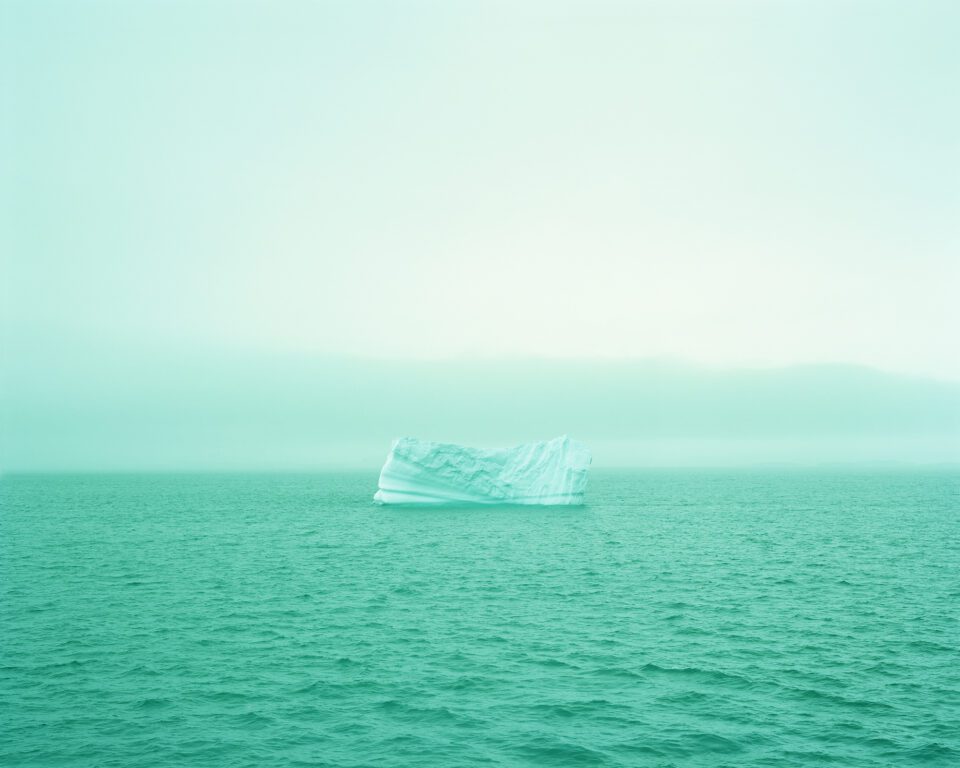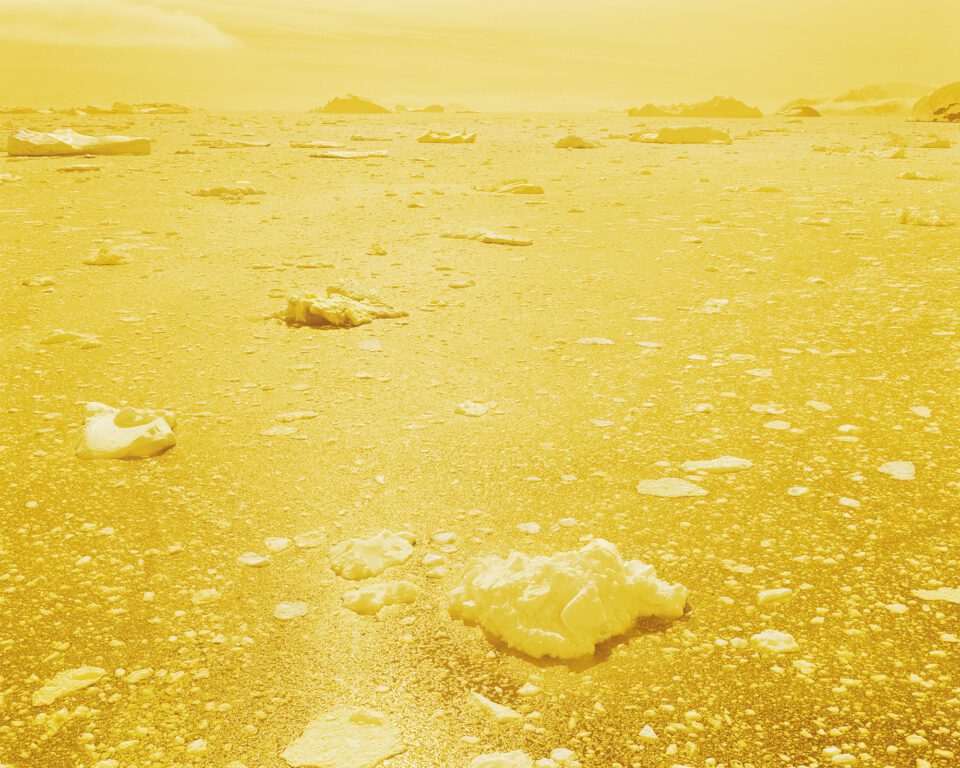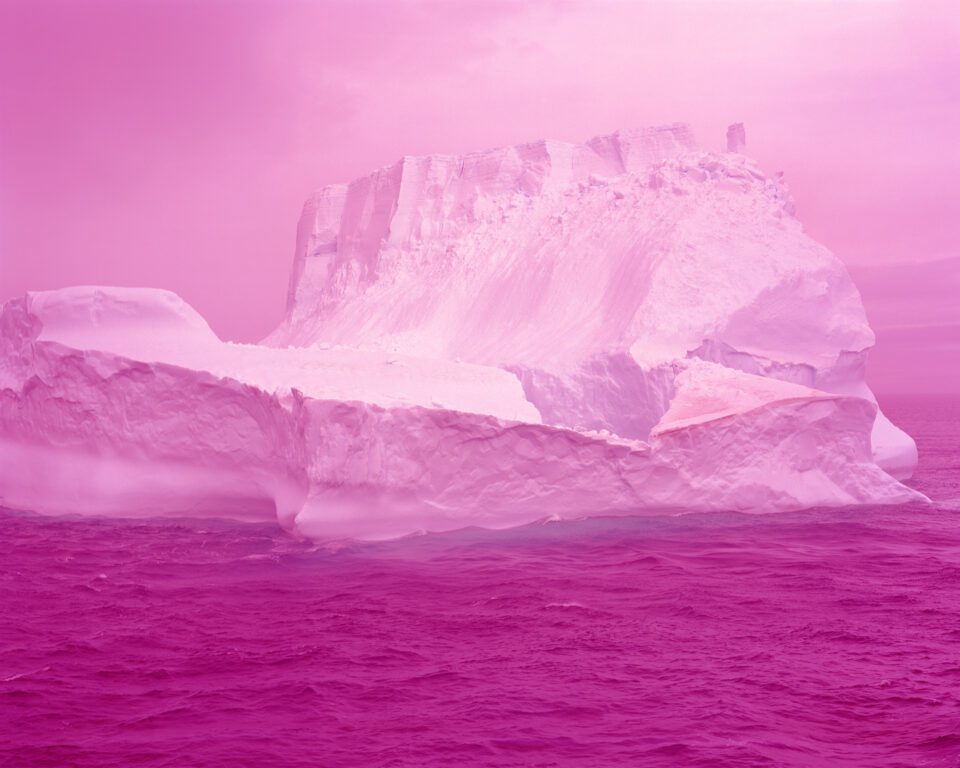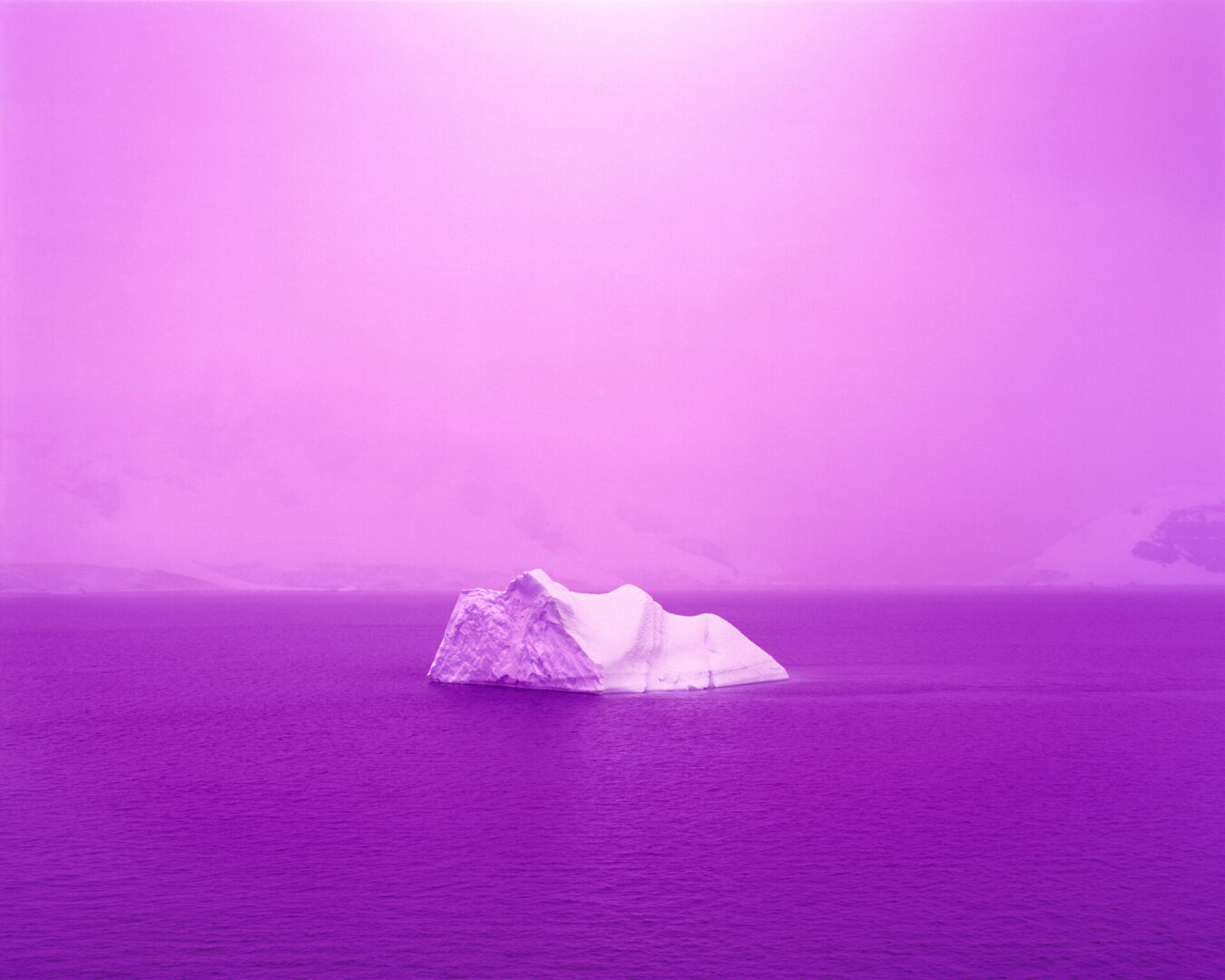David Benjamin Sherry (b. 1981) is concerned with the world’s wild places. The artist creates works that become photographic activism, with saturated colour palettes that highlight both the natural beauty of the landscape and its fragility. His series American Monuments (2017) documented sites that were being threatened by Trump’s administration, inspiring a sense of urgent in viewers. Each image depicts sites that have been reconsidered to make way for coal, uranium, oil and other interests. His hyperreal monochrome shots subvert traditions of the American landscape genre, bringing a queer perspective to a hetero-male dominated canon. Now, the artist focuses on a new part of the globe: Antarctica. The Waves, on display at Huxley-Parlour, continues Sherry’s exploration of environmental change, reaffirming a drive for conservation that runs throughout his career. We caught up with the artist to find out more about the creation of these vibrant photographs.
A: How did you start working behind the lens?
DBS: In 1999, I enrolled at the Rhode Island School of Design and took my very first photography class. I immediately fell in love with the tactile process of printing, as well as the immediacy of the medium and its ability to reveal truths – something that both impressed and intimidated me. At the time, I wasn’t ready to come out of the closet, so I channeled my energy into mastering the technical aspects of large-format photography and printing. After graduating, I moved to New York City and continued photographing, whilst assisting other artists, including photographer Justine Kurland, who encouraged me to apply to Yale’s MFA program. It was during my first semester there, at 26, that I finally came out to my friends, family and colleagues, prompted by a professor’s probing critique of my work’s queer subject matter. That experience revealed just how powerfully photography could expose truths I hadn’t yet spoken. From that point on, my practice shifted: I turned the camera outward, away from myself, and toward the world.

A: How do you see the role of photography in addressing existential threats like climate change?
DBS: We are inundated with images every day – of war, destruction, and climate change – circulating constantly through social media. This saturation often makes me feel that photography’s role is not enough; the repetition of such pictures has, in some ways, normalised our exposure to these existential threats. That said, I see my own work as part of a larger movement within contemporary artist to push against that. For me, the landscape is not passive scenery or a neutral document of time. Instead, it is a charged space where history, identity and climate intersect. In this way, photography can go beyond simply showing devastation; it can reframe our relationship to the environment and make visible the deeper connections between human presence and planetary change.
A: You employ analogue techniques and develop in the darkroom. What does working with film allow you to produce that digital can’t?
DBS: My artwork is intentionally a physical counterpoint to digital image-making and consumption. The darkroom is my sanctuary – an environment full of possibility. In 2007, I developed an alternative process for achieving a highly saturated monochrome colour, which transformed the photographic print into a tangible manifestation of that magic. Photochemically, the work echoes early experimentations with photography and its association with mysticism and alchemy. My process is methodical and meditative, creating a sense of communion with my subject and the natural world. Time slows down in the darkroom and in the act of shooting film. That is essential – it introduces warmth and presence into both the process and the final prints in a way that digital simply can’t replicate.

A: The Waves marks a shift in geography from earlier works. What drew you to Antarctica?
DBS: After spending two decades tracing that landscape, I felt compelled to begin a new chapter in my practice by travelling to Antarctica – often described as the “ground zero” of climate change. The polar region became a critical counterpart to my ongoing exploration of landscapes on the brink of collapse. The expedition brought me face-to-face with the visible impacts of a rapidly changing climate, whilst also allowing me to confront the intertwined legacies of exploration, colonisation and science that connect it back to my earlier works. At the same time, it offered a space to deepen recurring themes in my practice – queerness, survival and resilience – within one of the most extreme and fragile environments on earth.
A: As a queer artist, how do you challenge established perspectives to generate a new narrative?
DBS: I work within the tradition of large-format photography, but always with revisionist intent. My images use monumental scale, kaleidoscopic colour and an intensity meant to evoke the magic of direct experience in nature. Resisting digital flattening, I rely on slow, tactile processes in the darkroom – saturated monochrome prints that emerge through an alchemical practice. This fosters a sense of communion with the natural world and imbues the work with both physical and emotional resonance. As a queer artist deeply invested in photographic history, I aim to challenge the patriarchal and colonialist tropes embedded in Western landscape traditions – particularly the narratives of Manifest Destiny and rugged individualism. My practice strives to recover what has been repressed or overlooked, inviting viewers to see the land not as something to be consumed, but as something sacred to which we are intimately connected. In practice, this often means revisiting sites, attuning myself to weather and light and trusting intuition in composing an image. The use of surreal monochrome colour and mural-scale prints serves as an emotional entry point for the viewer: the colour becomes a mirror, encouraging them to recognise their own relationship to the earth. In this way, queerness inflects not only the subject matter but also the very processes of looking, feeling and imagining landscape anew.

A: How do you balance preservation and reimagining?
DBS: My photographs of Antarctica emphasise entropy and transience, standing in contrast to my earlier work on the mythologies of the American West. They dwell on instability. Within this coexistence of beauty and destruction, I seek out spirituality and hope. I believe art can move people in ways that evidence alone cannot. Wonder often succeeds where dread fails. These photographs are, in many ways, meditations on ice: images that both bear witness to collapse and hold space for spiritual awakening. In creating this work, I aim to inhabit impermanence, to reckon with a world unmooring itself and to confront the inseparability of beauty and loss.
A: Do you have a particular image that stands out as a highlight?
DBS: I don’t have a favourite, I love all of the works on view. This group of works has been edited from hundreds of pictures, so in my mind these are all my favourites!

A: What do you hope audiences take away from viewing the images?
DBS: I hope audiences connect with a sense of place – an almost mythological place, since most people will never set foot on Antarctica. I want viewers to feel both the excitement of the images and the pain of what they’re truly witnessing: melting Antarctic ice. What happens there will inevitably affect us all, destabilising climate systems and accelerating sea-level rise. Ice melt is one of the most visible signs of climate change, just as the Western landscape has long served as a symbolic terrain in my American projects. Both are hyper-visible subjects, layered with history and inquiry. My work engages that visibility – not to simply document threatened places, but to confront change itself. By choosing iconic sites for their instant recognisability, then subverting that familiarity through unexpected color and form, I aim to create a hybrid experience: recognisable yet transformed. This invites slower, more reflective looking. My practice mirrors my own response to these landscapes – both fascination and unease at the pace of environmental change. Ultimately, I hope the work encourages audiences to see and think about our shifting planet in new, adaptive ways.
The Waves is at Huxley-Parlour, 3–5 Swallow Street until 18 October: huxleyparlour.com
Words: Emma Jacob & David Benjamin Sherry
Image Credits:
1. Future, (Iceberg, Antarctica), 2025, David Benjamin Sherry © David Benjamin Sherry, image courtesy Huxley-Parlour.
2. Kingdom Come, (Glacier, Antacrtica), 2025, David Benjamin Sherry © David Benjamin Sherry, image courtesy Huxley-Parlour.
3. Sleeping Deliverance, (Iceberg, Antacrtica), 2025, David Benjamin Sherry © David Benjamin Sherry, image courtesy Huxley-Parlour.
4. Liberation, (Brash Ice, Antarctica) 2025, David Benjamin Sherry © David Benjamin Sherry, image courtesy Huxley-Parlour.
5. Pink Dynamism, (Iceberg, Antarctica), 2025, David Benjamin Sherry © David Benjamin Sherry, image courtesy Huxley-Parlour.





